- Italy Tours Home
- Italy Ethos
- Tours 2023
- Blog
- Contact Us
- Dolomites
- Top 10 Dolomites
- Veneto
- Dolomites Geology
- Dolomiti Bellunesi
- Cortina
- Cadore
- Belluno
- Cansiglio
- Carso
- Carnia
- Sauris
- Friuli
- Trentino
- Ethnographic Museums
- Monte Baldo
- South Tyrol
- Alta Pusteria
- Dobbiaco
- Emilia-Romagna
- Aosta Valley
- Cinque Terre
- Portofino
- Northern Apennines
- Southern Apennines
- Italian Botanical Gardens
- Padua Botanical Garden
- Orchids of Italy
Boite Valley: in the Shadow of Mount Antelao, “King of the Dolomites”.
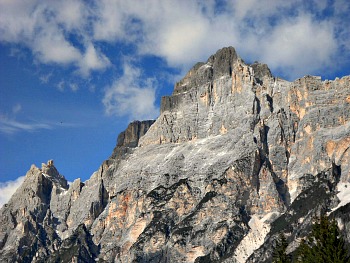
The Boite
Valley (Valle del Boite),
through which flows the river that gives it its name, covers the section of Cadore west of Pieve di Cadore, eventually leading to Cortina d'Ampezzo (see an image above of the Croda Marcora from San Vito di Cadore).
It comprises the municipalities of Valle di Cadore, Vodo di Cadore, Borca di Cadore, San Vito di Cadore, and – tucked away in a side valley – Cibiana di Cadore.
In this page, we are going to deal with these villages one by one, looking at what they have to offer both in terms of nature and cultural heritage.
Valle di Cadore
The first township we encounter travelling west of Pieve di Cadore is Valle di Cadore, which is in fact one of the most interesting historical centres in the whole region. In many ways, it is almost impossible to distinguish it from Pieve, as the strip along the National Road is seamlessly built – but once you reach the town centre, it is very distinctive.
It lies tucked away past a monumental fountain by a sharp bend of the National Road, where there are also two gothic buildings, Palazzo Piloni and Palazzo Costantini. Unfortunately, the National Road is all too often congested with traffic, spoiling the beauty and peace of this ancient square, but step into the historic part, and you’ll find yourself immersed in an oasis of quiet.
The main street (in fact, a very narrow strip known as “Via Romana” –‘Roman Way’) is still lined with noble ‘palazzetti’ (literally, small palaces), and many of them date back to the 16th century.
There is a reason for this concentration: this used to be a stretch of the main thoroughfare until the more modern “Strada d’Alemagna” (‘Alemania Way’, as it were – as it eventually leads to Germany) was traced in the second half of the 19th century.
The fact that these ‘palazzetti’ are built mainly in stone bears a clear indication of the fact that they were destined to the nobility – as vernacular architecture (i.e. the houses for the people), on the contrary, was at the time mainly built in wood.
At the very end of the historic part – on an open, panoramic point – the church of San Martino (Saint Martin) stands in majestic isolation. Although the church is very seldom open, it hosts in its interior important works of art (such as a Madonna and Saints by Francesco da Milano, 16th century).
From this location, beautiful views open up both over the lake at the bottom of the valley and on the surrounding mountains - primarily on the Antelao (3,263 m) – aptly nicknamed “King of the Dolomites”.
From Valle di Cadore some interesting excursions are possible, especially towards this most majestic of mountains. The “King of the Dolomites”, whose towering height (3,263 metres) hovers in fact above the whole length of the Boite Valley, can be accessed from here with a long and twisting road.
This is part of a classic walk from Valle: the ascent to Rifugio Costapiana, which can lead further up to the chapel of Saint Dionysius (Cappella di San Dionisio), with awe-inspiring views on the rock face of the Antelao, which gets closer and closer in all of its corrugated beauty as one goes along.
From there, it is possible to connect with paths that allow one to descend towards Calalzo or San Vito (see below) – but as they are in high altitude, those paths are recommended to experienced walkers only (see, below, the majestic rock face of Antelao follows the visitor all along; here, as it is seen from Valle, in the lower section of the Boite Valley).
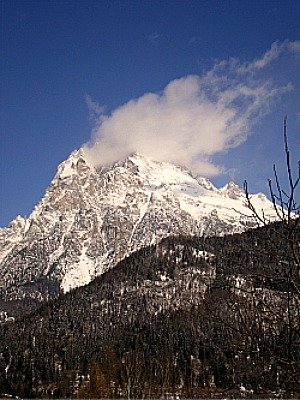
Travelling further alongside the Boite Valley will afford constantly varying perspectives on this most majestic of mountains – certainly one of the most fascinating in the Dolomites.
Some interesting examples of wooden, vernacular architecture can be found in the following hamlets of Suppiane and Venàs di Cadore, both belonging to the municipality of Valle di Cadore, while an interesting and easy trail is to follow the old “Via Romana” (the ancient track mentioned above) past Valle historic centre, all the way down to the Ponte di Rualàn – an old, medieval-looking humpback bridge.
Cibiana di Cadore
In order to visit the next village we need to take a diversion, and leave the National Road just past Venàs, turning left into the side valley that leads to Cibiana di Cadore.
Because of its being cut off from the main axis, this village has been isolated for many centuries; as a consequence, it was one of the places most badly hit by the emigration waves of the 19th and 20th century – until well after World War II.
Perhaps precisely for this reason, since the 1960s an initiative has been devised in order to attract visitors to the village. Over the years, this initiative has proved so successful that now Cibiana has become known as “the village that paints its history”.
Every other year a competition is being held to paint a new open-air mural, and the themes are always related to the history of the community and its traditions (emigration, seasonal work, local productions – such as the manufacturing of keys, which are a typical craft of Cibiana since the Middle Ages).
The relative isolation means also that many of the houses in vernacular architecture (with a style akin to that of Centro Cadore) are well-preserved; so, if you put together the idea of the old buildings with the outdoor murals, it is easy to imagine that the combination is a winning one – and therefore a recipe for success.
As a matter of fact, thanks to this initiative Cibiana has seen the number of its visitors growing slowly but steadily over the years, and its reputation as an open air museum has become more and more established.
The visit to the murals follows a circular route around the two main hamlets of Masariè and Pianezze.
Monte Rite and the Messner Mountain Museum
In more recent times, the betterment of the track to Monte Rite – with the creation of the botanic trail on the summit and the opening of the Messner Mountain Museum – has meant an additional boost in the number of visitors.
Despite all that, Cibiana has managed not to lose touch with its roots, and to retain an air of individuality that still bears no trace of mass-tourism, making it particularly appealing to those who are looking for a genuine, “off-the-beaten-track” Alpine destination.
Going back to the main axis of the Boite Valley now, as we continue to journey upstream towards Cortina, we’ll find that the next villages are all in close sequence.
Vodo and Borca di Cadore
Both Vodo and Borca di Cadore are dominated by the towering presence of the Antelao, which shows itself off in all of its glory, displaying perhaps its best aspect along this stretch of valley (pictured below, the Antelao as it appears from Borca).
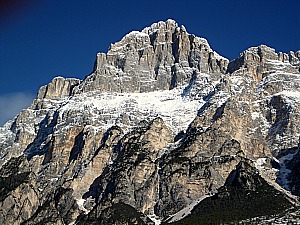
As if that were not enough, on the other side of the river there is yet another incredible sight: Monte Pelmo (3,164 metres) is also visible from here with its most appealing face – which makes it not difficult to understand why this mountain has traditionally been known as the “Caregon del Doge” (literally, the “Doge’s seat”), as from this particular viewpoint this is really what the Pelmo resembles to: a gigantic throne made of rock.
From Vodo di Cadore, several trails head in the direction of Pelmo, connecting in altitude with other tracks that lead past the watershed and descend into Zoppé di Cadore (in the Oltremonti area), eventually reaching the Zoldano (below, an image of Mount Pelmo as seen from Borca, in the mid Boite Valley).
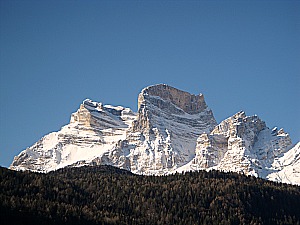
The tiny hamlet of Vìnigo opens up like a natural balcony in the middle section of the Boite Valley, and displays the gothic church of San Giovanni Battista, which contains a Madonna and Saints, attributed to Francesco Vecellio.
Borca di Cadore offers several interesting sights: in the outlying borough of Cancìa (where there is an old church with a beautiful onion-domed bell-tower, surmounted by an angel – one of the finest sights, in my view, of “old Cadore”), examples of traditional architecture (see an image below) sit almost face to face with the modern buildings of Corte di Cadore.
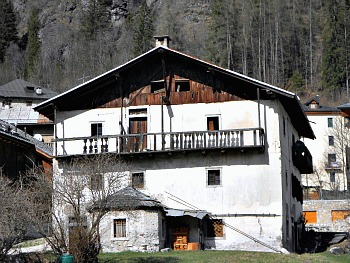
Corte di Cadore
This is a mountain resort newly founded in the late 50s/early 60s out of nothing, and spread on a rocky slope at the foothills of the Antelao. Given these premises, you would easily think of it as a concrete, soul-less development – but, in this case at least, you would be wrong.
Corte was in fact a project by the prolific architect Edoardo Gellner, who lived and worked for a long time in nearby Cortina, and was the author of many interesting architectural creations in the Alps and elsewhere (as an aside, he was also responsible for initiating a comprehensive survey of all the vernacular architecture buildings present in the mountainous part of the province of Belluno).
Although unfinished, Corte remains one of Gellner’s best creative outputs: it was conceived almost as a self-sufficient new town, made of second homes, and thought for the workers of ENI (an Italian integrated energy company).
In Gellner’s view, all the houses were intended to blend with their natural surroundings, and each of them had to benefit from direct access to woodland; the underlying idea – which also extends to the service buildings and the beautiful church – was to provide a continuum between the outside elements (rocks, trees and so on) and the materials and shapes used for the construction of the actual buildings (concrete, iron, wood).
Corte may not be to everybody’s taste, but I find it a compelling example of enlightened modern architecture, for its rare (and successful, in my opinion) attempt to engage in a dialogue with the natural environment. Noteworthy is also the church of Nostra Signora del Cadore.
San Vito di Cadore
A short distance upstream, the last village we encounter is San Vito di Cadore, which is a fairly developed mountain resort already falling under the ‘spell’ of Cortina, now only about ten kilometers away to the north.
As we are getting on the upper reaches of the Boite Valley, the landscape becomes more open, and the Dolomite scenarios also changes.
From here, the Antelao starts looking more like a pyramid (the typical, familiar shape it has when viewed from Cortina), while the Croda Marcora-Sorapiss group (3,205 m) takes centre stage; Monte Pelmo remains well visible on the other side of the valley, while the peaks of the Conca di Cortina (Cortina basin) also become part of the skyline (below, another image of the Croda Marcora pictured from San Vito).
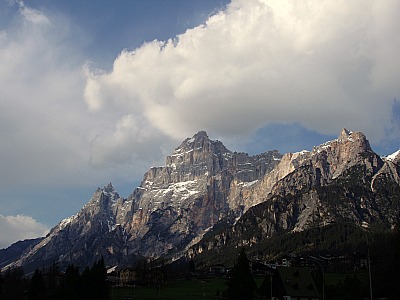
Because of its modern development, there is not perhaps much to admire in San Vito itself in terms of heritage, apart from two interesting ecclesiastic buildings.
One of them is the parochial church of San Vito and Moderanno, reconstructed in the late 1700s and displaying a gigantic St. Cristopher painted on the exterior, while the other (Madonna della Difesa) is a Gothic church erected after a vow in the 15th/16th century, at the time of the plague.
Although seldom open, the latter contains traces of old frescoes, plus a work by Francesco Vecellio (a painter belonging to Titian's family – another of his works is in the main church).
But certainly, given the location, it is the natural environment that takes priority here: on both sides of the valley there is an extensive network of paths leading up in altitude, connecting – along the slopes of the Antelao – with tracks coming from Calalzo and the Valle d’Oten, and therefore the possibility of accomplishing a circular trail (which is recommended to experienced hikers only).
An easier – but not less dynamic – option that deserves a mention, though, is the disused railway track that originally connected Calalzo to Cortina until 1964. After many years of neglect, in more recent times this has been turned into the “Cycle Route of the Dolomites”, which can be used by walkers and cyclists alike in all of its length (about 30 km).
It offers perhaps the best way to admire the subtle variations in the scenery and the ever-changing perspectives on the mountains, missed all too easily when driving. Also, as this used to be a railway, the gradient is always very gentle; the only downside – if you’re in for something more ‘natural’ – is that it is tarred.
Going northwards, this path will follow closely at the foothills of the Croda Marcora (3,154 m), whose impressive, almost vertical rock walls – often tainted with the red of iron dioxides – fall sheer on the underlying woodland.
Soon the path crosses at Dogana Vecchia (the Old Custom House) the historic boundary between the Austrian Empire and the Republic of Venice (later Napoleonic France), attested here for many centuries. An Hapsburg-looking building – still standing – used to be one of the stations along the line, past which one enters the territory of Cortina d’Ampezzo (in the image below, the Croda Marcora-Sorapiss group as viewed from Acquabona – the first hamlet in the Ampezzo basin, at the head of the Boite Valley).
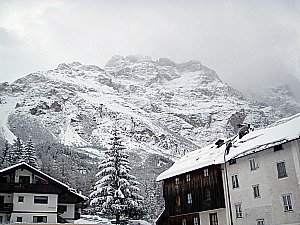
Return from Boite Valley to Cadore
Return from Boite Valley to Italy-Tours-in-Nature
Copyright © 2012 Italy-Tours-in-Nature

New! Comments
Have your say about what you just read! Leave me a comment in the box below.